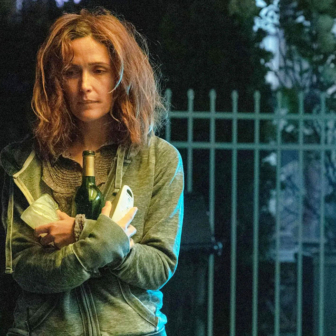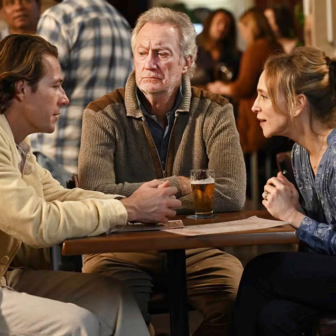Oscar nominations are out and bets are firming. The two current favourites are Roma — a glorious, haunting film I reviewed in November — and The Favourite, with which my Inside Story colleague Brian McFarlane engaged last month. Brian’s review, apart from language warnings, was remarkably, ahem, discreet. I think there is more to be said.
Superficially, The Favourite is a lesbian bodice-ripper of high style. There are plenty of these in print but few on the screen, apart from the 2002 BBC series Tipping the Velvet and Hulu’s recent Harlots, screening on SBS. This story of two favourites — Sarah, Duchess of Marlborough (a very spunky Rachel Weisz), and a young cousin, Abigail (Emma Stone, cunning, wide-eyed and flirty) — manoeuvring for the position of the Queen’s favourite at the court of the last Stuart monarch is enjoyable in the way Dangerous Liaisons (Stephen Frears, 1988) is enjoyable. Sexual power is a huge part of their armatures. There is spite, and revenge, and there is also desperation. As the obese, gout-afflicted Queen, Olivia Colman gives a performance completely without vanity, in which her loneliness, physical pain and emotional dependence are underscored.
With this, his sixth film, and his first with a big budget, Yorgos Lanthimos has great fun in the formal spaces of Hatfield House. He uses the long corridors and a fisheye lens to emphasise the isolation of the monarch and the desperation of the scrambling favourites. The production design is equally witty. Within these spaces, The Favourite achieves occasional eroticism: it does so, moreover, from the point of view of a disabled, dependent woman. Dependent she may be, but not stupid. She can tough it out when she must.
Historically, Anne was shrewder and smarter than the film allows her to be. She manoeuvred between Whigs and Tories, between Stuart secessionists, Scots and English, to advance the cause of a united and Protestant Great Britain. (She was raised an Anglican, despite her father’s secret defection to Catholicism.) I doubt that a single film could adequately encompass the politics, any more than a single film could encompass the nightmare historical drama that is Brexit. (The temptation to frame Anne as an icon of a united Great Britain has thankfully been resisted.) We see her here, widowed, midway through her reign, with factions jockeying either for more troops for the war of the Spanish succession, or for a complete pull-out. Sarah, of course, wants her husband, the old Duke, to have more troops.
Deborah Davis wrote the original script, first as a radio play. Does stripping out much of the politics, as Lanthimos and his second screenwriter Tony McNamara have done, make this a caricature?
Not completely. It is the first duty of British queens and princesses to breed. Decades ago, historian Antonia Fraser drew attention to the huge pressures on women of that time, high-born and low, to make babies. The lower orders bred their own labour; women were breedstock and labourers both. The women of the ruling class were equally bound, and underneath the trappings of royal romance, this is still true, though Hilary Mantel was pilloried for saying so.
Between her marriage at seventeen and her husband’s death when she was thirty-five, Anne endured seventeen pregnancies. Seventeen. Twelve miscarriages and five live births, four of whom died as infants. Only one, William, Duke of Gloucester, lived out his childhood, and he died at eleven, leaving his parents grieving. Imagine the punishing cycles of hope, sorrow and emotional distancing Anne endured. And survived. While running a kingdom.
Beside these facts, skirmishes about whether Sarah pleasured Anne or, as Sarah claimed, Abigail did, are trivial, and so are social media arguments about the history of cunnilingus and #MeToo-ish doubts about whether it’s a good idea to show three powerful women as able, at times, to be amoral and cruel. The Favourite is fiction, and the filmmaker may do as he wishes. In previous films Lanthimos has shown his fascination with the cruelties people may inflict on each other, for pleasure or out of boredom or for survival. Here he has reined it in, just a little. His is not a view of human nature that I share, but it could be a metaphor for the age.
In bringing us back to the personal, Lanthimos and his screenwriters use a clever metaphor to suggest Anne’s displaced maternalism, but his film, and Colman’s towering performance, left me wondering. Was Anne’s maternalism entirely projected onto the wider realm? Hers was not a matriarchy. There were too many powerful men manoeuvring about her, and the film shows us that. But she used what power she had astutely.
Managing to play off warring factions and unite a kingdom while her body slowly weakened, puffed, ached and drained her is a quite remarkable achievement. Despite Lanthimos’s fascination with cruelty, this revenge comedy turned tragedy sent me out with a whole stack of poignant questions. And that’s not a bad thing.
Green Book, from director Peter Farrelly, sets out to be a heart-warming parable about black–white friendship and the overcoming of prejudice. It’s comforting as custard. Or pasta. Or fried chicken. There’s a lot of comfort food in this film, but not much food for thought. It will challenge very few prejudices.
Mahershala Ali (Moonlight, The House of Cards, The Hunger Games) plays real-life musician Don Shirley, a brilliant classical composer and pianist who welded many forms. Shirley believed in the power of music to change people’s feelings, and for a time trained as a psychologist to demonstrate this, running real experiments with audiences in Cuba. In the 1960s, as a deliberate challenge to race segregation laws, he put aside an international classical music career to tour America with a jazz quartet. (The Negro Motorist Green Book, referenced in the film’s title, was a guide for non-whites seeking accommodation in the segregationist states.)
Viggo Mortensen plays Tony “Lip” Vallelonga, hired as Shirley’s driver and security guard. Together, Ali and Mortensen give this film considerable class. Mortensen put on forty pounds to play Vallelonga, and food plays as emotional a part as music in this film. There’s a weird fascination to be had in remembering the once-beautiful youth of his early films and the assured Strider of The Lord of the Rings while he is up there on a big screen stuffing his face.
The film plays off Shirley’s fastidiousness against Vallelonga’s wolfish appetites. Ali’s Shirley is quite startlingly elongated, and ramrod straight. The story picks its way through his closeted homosexuality: it’s there, but the psychological journey is actually the straight white man’s. There’s a fine dance here between exceptional actors, but dramatically this is a predictable film, every move signalled ahead. No insights, no new questions raised to disturb any complacency about the segregationist battles of the sixties. It’s engaging enough to send one out sated, but by the time we got to soul food I began to feel queasy. If this film’s glimpse of America’s segregationist history beats Spike Lee’s BlacKkKlansman it will do nothing to help Americans reconsider their past.
Finally, to Loro, Paolo Sorrentino’s film about Silvio Berlusconi, the salesman who launched his own political party to ward off judicial attacks on his tax evasion and corruption. Cut together from two films I saw last year in Italy, it runs almost three hours in our cinemas.
Though Sorrentino had hopes, Loro didn’t make the Oscar cut. He was also working on a second series of the deliciously cinematic television show The Young Pope, seen in Australia in 2017. A director can only handle so much, so Loro was released in two parts in Italian cinemas but didn’t make it to Cannes. That Sorrentino’s usual Italian co-financer, Medusa Films, is owned by Berlusconi’s Mediaset can’t have helped finesse it through to release.
The filmmaker had plenty to work with. Starting as a property developer in Milan, Berlusconi employed cajolery, the exchange of favours, and tax evasion to build his wealth. His first television station drew viewers by employing housewives to perform in striptease competitions, capturing an audience for his real estate promotions.
In a sense, Berlusconi was the prototype of Trump and Morrison. In the shambles of Italian politics after the tangentopoli scandals of the eighties and nineties, this marketeer saw a vacuum and created Forza Italia as the party symbolising Italian aspirations. Indeed, he used his media empire to reinforce those aspirations. For young men, it was to be a footballer (he bought AC Milan); for women, it was to be a velina prancing about on screen to keep Italians watching everything from a quiz show to a political commentary. George Clooney was once engaged to one.
In Italian, Loro means them. As in us and them. There is very little us in Loro, or at least in the three-hour version screening in Australia. In this version, the figure embodying these aspirations, a young hustler and pimp from Sicily played by Riccardo Scamarcio, fails to engage. Toni Servillo, whose performances have built Sorrentino’s career, does better as the aged Berlusconi. With a fixed rictus smile and the famous, by now rigid, hair transplant, he’s like a ghostly Robert Mugabe.
There are some terrific set pieces in this film. Berlusconi’s luxury villa in Sardinia, with its artificial lake, mechanical volcano and curious sheep (presumably also representing us) makes great absurdist comedy of the fantasies of a man with immense will and limited imagination. In a tour de force scene, Servillo’s Berlusconi tests his marketing skills by cold-calling a woman chosen at random, to sell her a non-existent apartment. But really, even this cut-down version of Loro is baggy, and the story seems to have lost some of its rhythms. At times it’s tedious, like a party from which there is no escape. (And Sorrentino is very fond of party scenes.)
Other attempts have been made to capture Berlusconi and Berlusconism on film. Nanni Moretti tried, and failed, with The Caiman in 2006. That film primarily signalled the immense media power Berlusconi wields. The best I’ve seen is Videocracy, a 2009 documentary in which Erik Gandini, a Swedish Italian, examined the way Berlusconi shaped Italian aspirations. Loro amplifies most of Gandini’s points, and makes another: the salesman and former crooner wants to be loved.
The real Berlusconi, now eighty-two, may still contemplate a bid for the Italian presidency, vacant in 2022. He’s come back before. He’s served a piddling six months of community service for tax evasion, and Italy’s Supreme Court has cleared the way for his return to elected office. Given the power the hard right is exercising in Italian politics, that’s not a pretty thought. •




